February 20, 2008 Vivid Watercolors Capture Historic Fort Worth Buildings in Exhibition at the Amon Carter Museum

Fort Worth, TX, February 20, 2008—Seventeen brilliant watercolor paintings of some of Fort Worth’s most iconic historic buildings will be on view at the Amon Carter Museum in the exhibition Fort Worth Landmarks in the 1950s: Watercolors by Bror Utter from March 8 through June 15. Admission is free.
Executed primarily between 1956 and 1957, the works feature homes, churches, businesses, and other structures symbolic of a prospering, evolving community whose economy was founded on the agricultural and cattle trades. The original Star-Telegram Building, the Old Post Office, Armour and Company, and the Martin Casey Building are a few of the structures Utter painted that have since been demolished. The Knights of Pythias Castle Hall, the residence of F. Hays McFarland and the St. Ignatius Academy are among the buildings that still stand.
“The Carter is honored to be the steward for these vivid and compelling reminders of Fort Worth’s long-standing concern for historic preservation,” said Jane Myers, the Carter’s senior curator of works on paper.
The body of work was commissioned in 1956 by the First National Bank of Fort Worth at the urging of Samuel Benton Cantey III, a bank vice president and Utter’s longtime patron. Cantey viewed the project as symbolic of First National’s integral community presence and as a means for preserving the spirit and character of Fort Worth’s storied past. The series was infused with a sense of urgency by the impending demolition of the Star-Telegram Building, built in 1904 in downtown Fort Worth. The structure, which once housed Amon G. Carter’s burgeoning newspaper business, was only days away from the wrecker’s ball when Utter sketched his first drawings. He completed Star-Telegram Building in January 1957, with other paintings following at the rate of about one a month. Within a few years of the commission’s completion, more than half of the buildings Utter captured had been razed.
Utter was a gifted watercolorist, and he reveled in the lively architectural styles the late-Victorian structures presented: Queen Anne, Second Empire, Romanesque, and Gothic Revival. The artist also merged his love of vivid colors with the era’s preference for such materials as red sandstone and vibrant residential paints.
When the works were displayed in the bank’s lobby, public reaction was so positive that Cantey and bank president J. Lee Johnson Jr. delayed plans to install the series in the bank’s dining area, choosing instead to send it on a two-year exhibition tour that included fifteen stops in twelve Texas cities. Colleges and museums in communities both large and small hosted the exhibit. After the watercolors returned to the First National Bank, they were displayed in staff areas until they were eventually relegated to storage. In recent years, the works were on public view in the building’s lobby at 500 West Seventh Street.
Beginning in the late 1990s, Ruth Carter Stevenson, the museum board’s president, made several overtures to acquire the works for the museum. When the bank building was acquired in early 2007 by First on 7th, an entity run by the Darden family of Fort Worth, conditions turned favorable and Stevenson’s efforts were rewarded. The works were gifted to the museum and, in return, the museum produced for the bank archival-quality, full-color reproductions of the watercolors for display in their lobby. (Archival reproductions of several of the works are available from the Museum Store.)
The entire set of the watercolors will be on display in the Carter’s Works on Paper Galleries. The stories of each building, along with photographic reproductions, will complement the works.
Several works by Bror Utter are also on view at the Carter in the special exhibition Intimate Modernism: Fort Worth Artists in the 1940s, which reveals the story of several artists, including Utter, who together formed the first modern art colony in Texas.
At the Amon Carter Museum, visitors learn about this country’s fascinating social and cultural history through great works of American art.